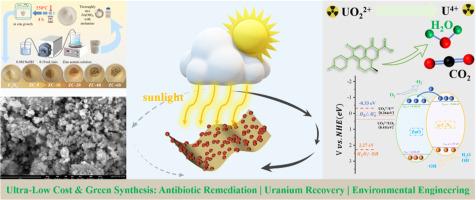One-pot synthesis of ZnO/g-C3N4 with enhanced photocatalytic activity for levofloxacin degradation and uranium extraction
IF 6.3
2区 材料科学
Q2 CHEMISTRY, PHYSICAL
引用次数: 0
Abstract
This study synthesized ZnO/g-C3N4 heterojunctions via a facile one-pot method. Specifically, solid-state grinding of Zn(OH)2 and melamine followed by calcination at 550 °C for 4 h enabled in situ co-growth of ZnO and g-C3N4. Characterization through XRD, FTIR, XPS, and SEM confirmed successful synthesis of the material by revealing its microstructure and chemical composition. TG and BET analyses further revealed enhanced active sites in the composite relative to individual components. UV-Vis DRS, EIS, and Mott-Schottky measurements validated superior optoelectronic properties of the hybrid material. Under simulated solar irradiation (55 W Xe lamp), ZC-10 (1.0 g/L) achieved 92 % degradation of levofloxacin (LVF, 10 mg/L in 100 mL solution) within 120 min, exhibiting reaction rates 2.4-fold and 3.8-fold higher than pristine ZnO and g-C3N4, respectively. Notably, in uranium extraction experiments (100 W Xe lamp), ZC-10 (0.20 g/L) achieved a total uranium removal mass of 398 mg/g with 99 % efficiency from 50 mL of 80 mg/L U(VI) solution after 240 min. Cycling tests confirmed the robust stability of the photocatalyst. Mechanistic investigations via EPR and targeted quenching experiments identified as the primary reactive species responsible for LVF degradation. This integrated ZnO/g-C3N4 system demonstrates great potential for environmental engineering applications in antibiotic remediation and uranium recovery.

一锅法合成ZnO/g-C3N4对左氧氟沙星降解和铀萃取的光催化活性增强
本研究采用简易的一锅法合成ZnO/g-C3N4异质结。具体来说,将Zn(OH)2和三聚氰胺进行固态研磨,然后在550℃下煅烧4小时,可以实现ZnO和g-C3N4的原位共生长。通过XRD, FTIR, XPS和SEM表征,揭示了材料的微观结构和化学成分,证实了材料的成功合成。TG和BET分析进一步揭示了复合材料中相对于单个成分的活性位点的增强。UV-Vis DRS, EIS和Mott-Schottky测量验证了混合材料优越的光电性能。在55 W氙灯模拟太阳照射下,ZC-10 (1.0 g/L)对左氧氟沙星(LVF, 10 mg/L, 100 mL溶液)的降解率在120 min内达到92%,反应速率分别是原始ZnO和g- c3n4的2.4倍和3.8倍。值得注意的是,在铀萃取实验(100 W氙灯)中,ZC-10 (0.20 g/L)对50 mL 80 mg/L的U(VI)溶液进行240 min后,总铀去除率为398 mg/g,效率为99%。循环试验证实了光催化剂的稳定性。通过EPR和靶向猝灭实验进行的机制研究发现,·O2−是LVF降解的主要反应物质。该ZnO/g-C3N4集成体系在抗生素修复和铀回收等环境工程领域具有广阔的应用前景。
本文章由计算机程序翻译,如有差异,请以英文原文为准。
求助全文
约1分钟内获得全文
求助全文
来源期刊

Surfaces and Interfaces
Chemistry-General Chemistry
CiteScore
8.50
自引率
6.50%
发文量
753
审稿时长
35 days
期刊介绍:
The aim of the journal is to provide a respectful outlet for ''sound science'' papers in all research areas on surfaces and interfaces. We define sound science papers as papers that describe new and well-executed research, but that do not necessarily provide brand new insights or are merely a description of research results.
Surfaces and Interfaces publishes research papers in all fields of surface science which may not always find the right home on first submission to our Elsevier sister journals (Applied Surface, Surface and Coatings Technology, Thin Solid Films)
 求助内容:
求助内容: 应助结果提醒方式:
应助结果提醒方式:


